More info
Find Travel Agents Near You
Home / 50 Years of Tourism: PNG’s Golden Jubilee
From the 16th of September, 2025, to the 15th of September, 2026, this marks a year-long national journey of unity, reflection, and forward momentum
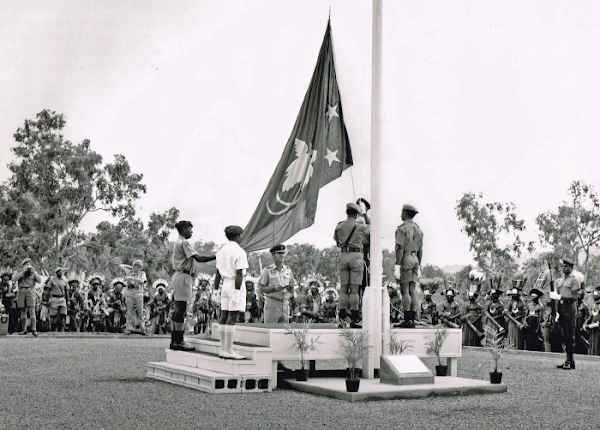
Since gaining independence in 1975, Papua New Guinea has welcomed the world with stories as rich and diverse as its landscapes and cultures. The early years of tourism were marked by fearless explorers drawn to our untouched coastlines, rugged mountains, and vibrant tribal traditions—experiences that set PNG apart as one of the last great adventures on Earth.
For five decades, tourism has grown through the vision of pioneers, the strength of local communities, and a deep commitment to preserving our natural and cultural heritage. These foundations have carried us far—building an industry that supports livelihoods, shares our identity, and invites global visitors to see Papua New Guinea through our eyes.
As we mark 50 years, we honour those who paved the way—and we look forward with purpose. With a renewed focus on sustainability, innovation, and inclusion, we are transforming tourism into a force that shapes a brighter future for all Papua New Guineans.
Now, as the world rediscovers authentic, meaningful travel, Papua New Guinea stands ready—not just as a destination, but as a proud nation with stories to tell, cultures to share, and a tourism industry that reflects the strength and soul of its people.
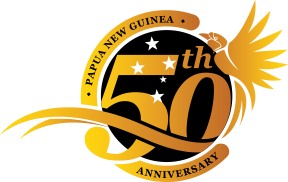
This commemorative logo marks Papua New Guinea’s 50th Independence Anniversary, a golden milestone celebrated by the Tourism Promotion Authority under the theme:
“Celebrating 50 Years of Tourism in Papua New Guinea – Honouring Our Past, Transforming Our Future.”
The Golden “50”

Bold and striking, it signifies five decades of national pride, progress, and resilience since gaining independence in 1975. The gold hue represents prosperity, strength, and the value of our collective journey.
The Bird of Paradise
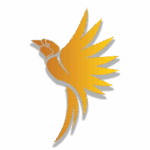
A national icon in flight, it symbolizes Papua New Guinea’s vibrant cultural identity and its unique allure as a tourism destination. Its wings spread forward, representing aspiration, transformation, and hope for the future.
The Southern Cross

Featured within the number 50, these stars link to the national flag, symbolizing our place in the Pacific and shared heritage with other southern nations. It also reflects unity and guidance.
Flowing Ribbon

The dynamic sweep around the number 50 evokes movement and continuity — a journey of growth in tourism that honours our cultural roots while propelling us into a sustainable and innovative future.
Circular Emblem
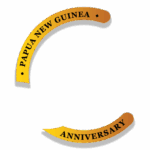
The ring bearing the words “Papua New Guinea Anniversary” encircles the design, portraying unity, inclusiveness, and the shared responsibility of shaping the next 50 years of tourism.
This logo serves as a unifying symbol for all celebrations throughout 2025, reflecting both national pride and the evolving story of tourism in Papua New Guinea — a journey rooted in tradition and driven by vision
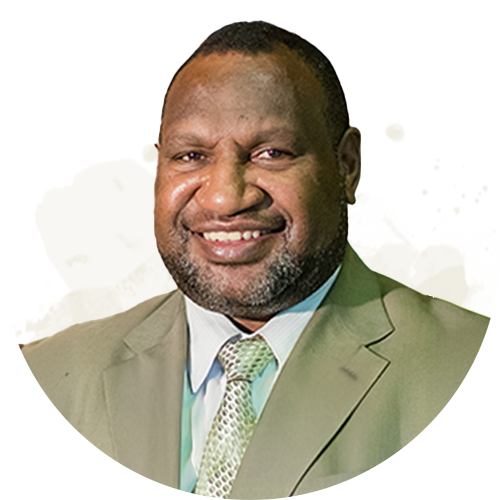
Tourism has enormous potential in our nation and we can make it happen. Who says dreams don’t come to reality? Dreams do come true. And I say this because I’ve seen and made it happen before.
Honourable James Marape, MP
As part of Papua New Guinea’s Golden Jubilee celebrations, the Tourism Lifetime Achievement Award honours individuals whose lifelong dedication has shaped the nation’s tourism industry. These pioneers have played a vital role in promoting PNG’s unique culture, environment, and people to the world. Their legacy reflects the spirit of innovation, resilience, and community that has defined 50 years of tourism in an independent Papua New Guinea.
1880s
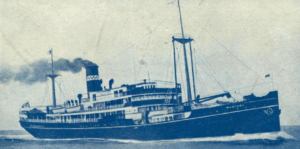
Picture: The SS Montero of Burns, Philp & Co, Limited during the late 1800s (Credit: Wikipedia)
1884: First Tourist Cruise to Papua New Guinea: Burns Philp & Company Limited launched the 'New Guinea Excursion Trip' in 1884, marking the first organized tourist cruise to Papua New Guinea. This five-week voyage from Thursday Island is considered the official beginning of tourist cruises in the South Pacific.
Reference: Wikipedia – Tourism in Papua New Guinea
1920s
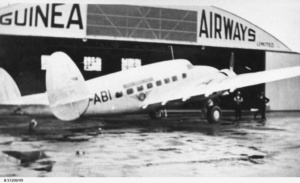
Picture Credit: State Library South Australia
1927: Establishment of Guinea Airways
Guinea Airways Limited was established in November 1927 to support the gold mining industry in Morobe, playing a pivotal role in aviation, mining and tourism.
Reference: History of Lae – Wikipedia
1930s
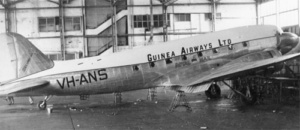
Picture Credit: South Australia Aviation Museum
1940s
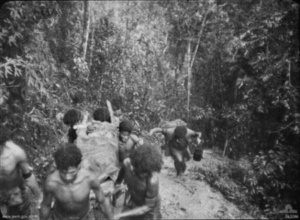
Picture: Native Papua New Guineans carrying a wounded soldier of the Allied Forces up a mountain along the Kokoda Track. (Credit: Australian War Memorial)
1942–1945 (WWII): 1.5 million foreign soldiers arrive in PNG; early war tourism begins post-war with visits to sites like Kokoda and Rabaul.
Reference: Promoting the Nation: Conflicting Theories of Tourism during Decolonization in Papua New Guinea, 1960–70s
1950s
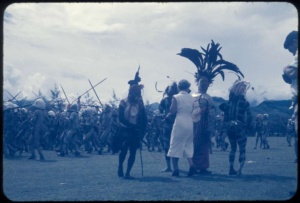
Picture: The famous Asoro Mudmen of Goroka in the late 1950s (Credit: Meigan, Tom - National Library of Australia)
1957: Inaugural Goroka Show Organized by Australian Kiaps
The first official Goroka Show took place in 1957, organized by Australian patrol officers (kiaps) to unite Eastern Highlands tribes through cultural performances and sing-sings. The event became a hallmark of PNG’s cultural celebrations.
References: Papua New Guinea Tourism, ABC News, Dive Discovery, PNG Attitude
1960s
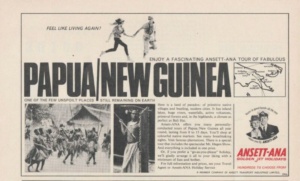
Picture: An old advertisement of the Ansett Ana Tours in Papua New Guinea (Credit: P. Worsley, Pinterest)
1960: The Papua and New Guinea Tourist and Travel Association (PNGTA) is established by private industry with support from the Australian colonial government, formalizing tourism promotion for the first time.
1961: The first Hagen Show is held (after the Goroka Show in 1957), organized by kiaps (patrol officers) to showcase highlands culture to both locals and tourists.
1964:
PNG’s first House of Assembly is formed, introducing limited Indigenous political representation.
The International Bank for Reconstruction and Development (World Bank) urges Australia to prioritize tourism investment in infrastructure like hotels and airports.
Fiji’s success in tourism becomes a model, especially with its soft imagery and mass tourism strategies.
March 9, 1966: The second reading of the Tourist Board Bill sees heated debate. Indigenous leader John Guise pushes for Papuan and New Guinean representation on the new board to safeguard cultural dignity.
August 18, 1966: The Papua and New Guinea Tourist Board (PNGTB) is officially established to promote PNG overseas and coordinate tourism growth.
1967: PNGTB begins operations. The board is dominated by expatriates; only four Indigenous members serve during its lifespan.
1968–1973: PNGTB ramps up marketing using brochures, posters, and travel writers. Tourist arrivals rise from 13,444 in 1965 to over 44,000 by 1973.
1970s
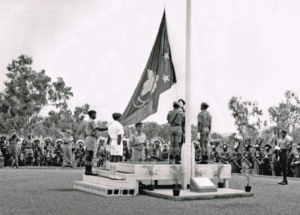
Picture: The Raising of the Papua New Guinean Flag on September 16th, 1975 (Credit: Colombo Plan Staff College)
1972:
PNGTB transitions into the Papua New Guinea Tourist Authority (PNGTA), signaling a shift towards national control.
Legu Bate is promoted as training supervisor – a significant milestone for Indigenous women's involvement in tourism.
1973:
Godfrey Benjamin becomes the first Indigenous executive director of the PNGTA.
Talair (Territory Airlines of Papua New Guinea) announces the localization of Talco (PNG’s largest tour operator), splitting it into new locally owned companies to ensure Indigenous participation.
The PNGTA becomes the Office of Tourism, tasked with aligning tourism policy with national development goals.
PNG launches its first Miss PNG pageant. Eva Arni from Buka wins and later competes internationally, symbolizing a modern image for PNG.
September 1975: Papua New Guinea Gains Independence
PNG gained independence from Australia on 16 September 1975, marking a new era of self-governance and national identity.
Reference: Wikipedia – Papua New Guinea Independence
1976:
Post-independence tourist arrivals fall (from 44,097 in 1973 to 26,374 in 1976).
A tourism development plan is commissioned, focusing on attracting respectful tourists and protecting PNG’s society and environment.
Christopher Talie becomes associate director of the Office of Tourism—the second Indigenous person to hold a senior role in the agency.
Although a tourism plan is completed, it is not released. Stakeholders express concern about the government’s silence and lack of clear direction.
1980s
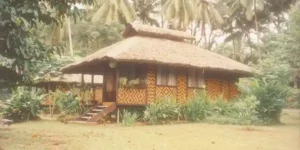
Picture: One of the first bungalows at the Walindi Plantation Resort in 1983 (Credit: Walindi Plantation Resort)
1980: Sir Peter Barter Establishes Melanesian Tourist Services
Sir Peter Barter founded Melanesian Tourist Services, operating cruises and the Madang Resort, boosting tourism in Madang.
Reference: PNG Travel – History Tours
1989: Sepik Spirit Launch
Bob Bates introduced the Sepik Spirit, PNG’s first floating lodge, promoting river-based eco-tourism.
Reference: PNG Travel – History Tours
1990s
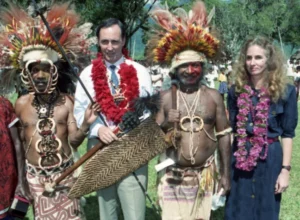
Picture: The 24th Australian Prime Minister Paul Keating and his wife Annita Keating, Kokoda, Papua New Guinea, 26 April, 1992 (Credit: Peter Morris/Sydney Morning Herald)
1991: South Pacific Games Held in Port Moresby
PNG hosted the 1991 South Pacific Games, showcasing the nation to regional visitors and promoting sports tourism.
Reference: Wikipedia – 1991 South Pacific Games
1991: Malolo Plantation Lodge Acquisition
Bates acquired and upgraded Malolo Plantation Lodge, enhancing coastal tourism in Madang.
Reference: PNG Travel – History Tours
1996: PNG Wins First PATA Gold Award
PNG received its first international tourism award—a PATA Gold Award for cultural tourism marketing.
Reference: PATA
2000s
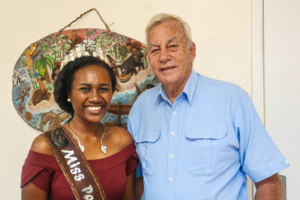
2001: Sir Peter Barter Knighted for Services to Tourism and Health
His contributions to the sector were officially recognised, celebrating decades of leadership and innovation.
Reference: PNG Travel History
2003: Bensbach Wildlife Lodge Opens in Western Province
Founded by Bob Bates, the lodge enhanced eco-tourism by offering wildlife viewing and conservation experiences.
Reference: PNG Travel History
2006: Rondon Ridge Opens Near Mount Hagen
Bates further expanded eco-lodging options with this luxury accommodation set in the Highlands.
Reference: PNG Travel History
2010s
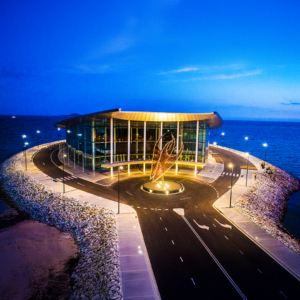
The APEC Haus in Port Moresby. (Photo Credit: David Kirkland)
2010 & 2018: Papua New Guinea Hosts Miss Pacific Islands Pageant
PNG hosted this key cultural pageant twice in the decade, promoting Pacific unity and PNG’s role in regional tourism.
Reference: PNG Tourism Promotion Authority
2015: First Miss Pacific Islands Winner from Papua New Guinea – Abigail Havora
Abigail Havora’s win spotlighted PNG’s cultural beauty on a regional stage.
Reference: Pacific Islands News Association (PINA)
2017: Papua New Guinea Hosts Rugby League World Cup Matches
PNG hosted key matches during the Rugby League World Cup, attracting international fans and media attention.
Reference: Rugby League World Cup
2018: Papua New Guinea Hosts APEC Summit in Port Moresby
The APEC Summit placed PNG on the global economic stage, boosting infrastructure and international visibility.
Reference: APEC Official Website
2019: Growth of Ecotourism and Adventure Travel
Community-based tourism projects and trekking/dive adventures grew, increasing PNG’s eco and adventure tourism profile.
Reference: Papua New Guinea Tourism
2020s
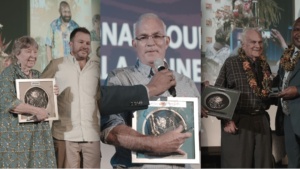
Presentation of the Tourism Lifetime Awards during the National Tourism Conference & Expo Gala Dinner (Credit: PNGTPA)
2021: Passing of Sir Michael Somare
On February 25, 2021, Sir Michael Somare, Papua New Guinea's first Prime Minister and known as the "Father of the Nation," passed away at the age of 84. His death marked the end of an era in PNG's political and tourism history.
Reference: The Guardian
2022 & 2023: Hosting of the Pacific Bowl Championships
Papua New Guinea successfully hosted the Pacific Bowl Championships in both 2022 and 2023, showcasing its capacity for major regional sports events and boosting sports tourism in the country.
Reference: Pacific Bowl Official Website
2024: Closure of Kokoda Track Due to Landowner Protests
Landowner disputes led to the indefinite closure of the Kokoda Track, impacting trekking tourism and raising issues of benefit-sharing.
Reference: The Guardian
2025: National Tourism Conference & Expo in Port Moresby
Marking PNG’s 50th independence anniversary, this conference brought stakeholders together to innovate and strategise sustainable tourism growth.
Reference: PNG Tourism Promotion Authority
Follow our Social Media Pages for more information
"*" indicates required fields
Thank you for submitting your proposal for the Visital Arrival System (VAS) Upgrade! We will take a look at your submission, and should you be successful, we will contact you.
However, if you do not hear from us, please consider your submission as unsuccessful.
Kind regards,
The Papua New Guinea Tourism Promotion Authority

Thank you for submitting your business form. We will have our team look over the details and then contact you once we have added your details to our website.